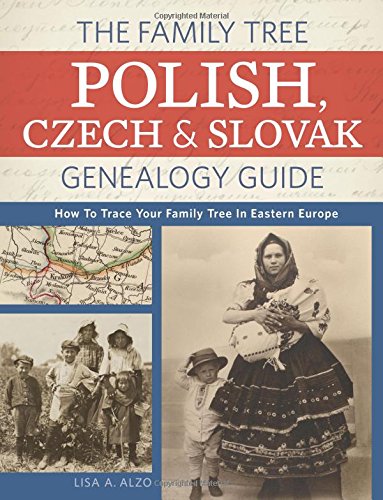Episode 195
The Genealogy Gems Podcast
Episode 195
with Lisa Louise Cooke
In this episode, I’m celebrating the 100th episode of another podcast I host: the Family Tree Magazine podcast. So I’ll flashback to one of my favorite interviews from that show, an inspiring get-in-shape conversation for your research skills: how you can strengthen your research muscles and tone those technology skills to find and share your family history.
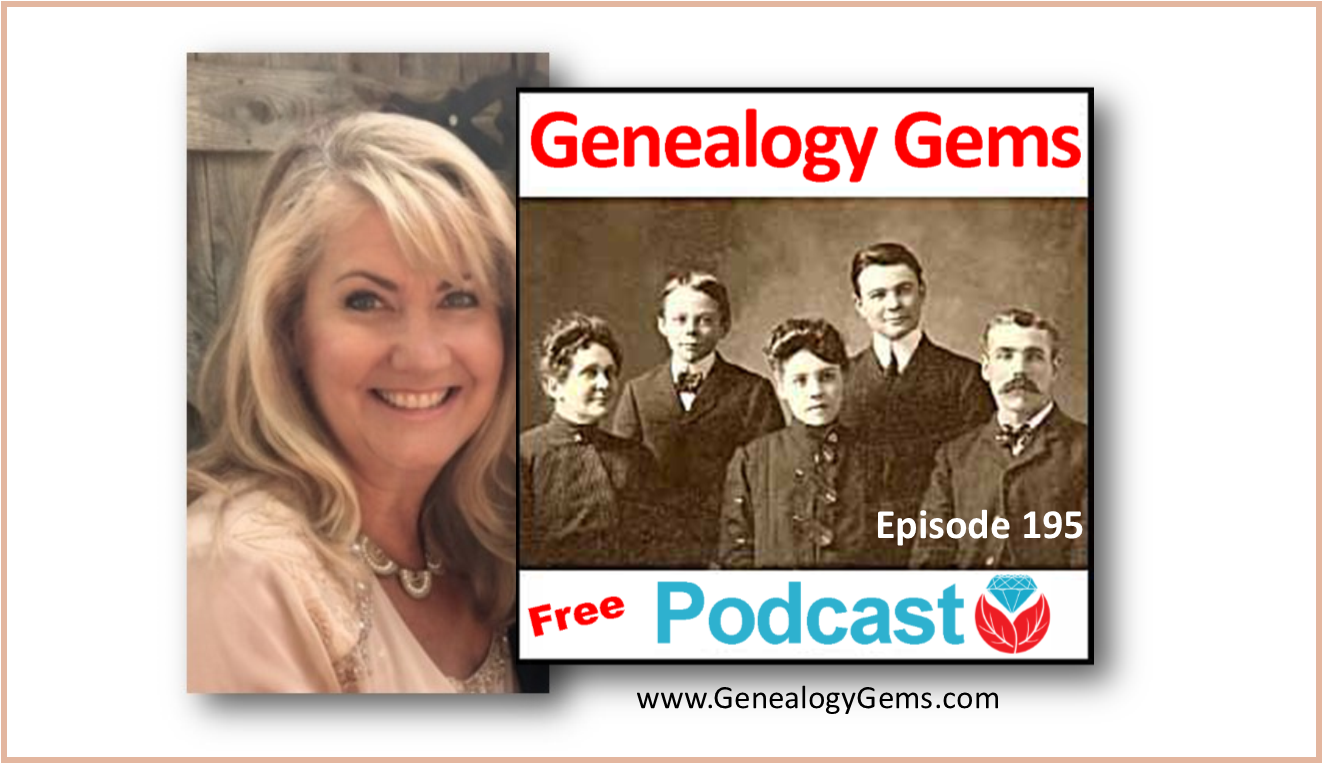
Genealogy Gems Podcast Episode 195
Listen now – click the player below
More episode highlights:
- News on Chronicling America and Scotland’s People;
- Comments from guest expert Lisa Alzo on millions of Czech records that have recently come online;
- A YouTube-for-genealogy success story from a woman I met at a conference;
- An excerpt from the Genealogy Gems Book Club interview with Chris Cleave, author of Everyone Brave is Forgiven;
- Diahan Southard shares a DNA gem: the free website GEDmatch, which you might be ready for if you’ve done some DNA testing.
NEWS: GENEALOGY WEBSITE UPDATES
- Scotland’s People
- Findmypast.com: Scottish records
- Chronicling America
- Chronicling America: New state partners join the program
- Chronicling America: Expanding its current scope
- MyHeritage Adds DNA Matching
NEW RECORDS ONLINE: FREE CZECH RECORDS AT FAMILYSEARCH.ORG
- Czech Republic Church Records 1552-1963
- Czech Republic Land Records 1450-1889
- Czech Republic School Registers 1799-1953
On browse-only records:
Though not fully indexed, the new Czech browse-only records number over 4 million. Click here learn how to use browse-only collections on FamilySearch.org.
Lisa Alzo, Eastern European genealogy expert and author of the new book The Family Tree Polish, Czech and Slovak Genealogy Guide comments on the significance of these records coming online:
“These records are a real boon for Czech researchers because at one time the only to get records such as these was to write to an archive and taking a chance on getting a response or spending a lot of money to hire someone to find the records or to travel there yourself to do research in the archives.
The church records contain Images and some indexes of baptisms/births, marriages, and deaths that occurred in the Roman Catholic, Evangelical Lutheran, and Reformed Church parishes, as well as entries in those registers for Jews.
Land transactions containing significant genealogical detail for a time period that predates parish registers. The collection includes records from regional archives in Opava and Tebo and from the district archive in Trutnov.
School registers contain the full name for a child, birth date, place of birth, country, religion and father’s full name, and place of residence.
While researchers should keep in mind that not everything is yet online, and FamilySearch will likely add to its collection, having these records from FS is an amazing resource for anyone whose ancestors may have come from these areas. And hopefully, there are more records to come!”
GENEALOGY GEMS NEWS
Story of My Life by Sunny Morton, life story-writing journal available as a print workbook and as a writeable pdf e-book
 Genealogy Gems app users: For those of you who listen to this show through the Genealogy Gems app, your bonus handout is a PDF document with step-by-step instructions and helpful screenshots for Google image search on mobile devices. The Genealogy Gems app is FREE in Google Play and is only $2.99 for Windows, iPhone and iPad users
Genealogy Gems app users: For those of you who listen to this show through the Genealogy Gems app, your bonus handout is a PDF document with step-by-step instructions and helpful screenshots for Google image search on mobile devices. The Genealogy Gems app is FREE in Google Play and is only $2.99 for Windows, iPhone and iPad users
Lisa Louise Cooke uses and recommends RootsMagic family history software. From within RootsMagic, you can search historical records on FamilySearch.org, Findmypast.com and MyHeritage.com. In the works: RootsMagic will be fully integrated with Ancestry.com, too: you’ll be able to sync your RootsMagic trees with your Ancestry.com trees and search records on the site.
Keep your family history research, photos, tree software files, videos and all other computer files safely backed up with Backblaze, the official cloud-based computer backup system for Lisa Louise Cooke’s Genealogy Gems. Learn more at http://www.backblaze.com/Lisa.
Review your search results especially those that pop up in the Images category.
MAILBOX: Robin’s YouTube Success Story
 YouTube video with Robyn’s father: Cleves, Ohio: Edgewater Sports Park
YouTube video with Robyn’s father: Cleves, Ohio: Edgewater Sports Park
The Genealogist’s Google Toolbox, 2nd edition has an entire chapter on using YouTube to find family history in historical videos
YouTube for Family History: Finding Documentaries about Your Family
MAILBOX: FEEDBACK ON THE PODCASTS

Free, step-by-step podcast for beginners and a “refresher” course: Family History: Genealogy Made Easy
Genealogy Gems Premium podcast
SHAPING UP WITH SUNNY MORTON
Family Tree Magazine Podcast celebrates 100th episode

Sunny Morton has get-in-shape advice for us from strengthening research skills to toning tech muscles–from the article “Shaping Up” featured in the March 2010 issue of Family Tree Magazine.
More resources for genealogy education:
- Genealogy Gems Premium eLearning membership
- Family Tree University
- National Genealogical Society Educational Courses
- Boston University Programs in Genealogical Research
- Southern California Genealogical Society Jamboree annual conference
GENEALOGY GEMS BOOK CLUB: Everyone Brave is Forgiven, the best-selling novel by British author Chris Cleave. A love story set in World War II London and Malta. This story is intense, eye-opening and full of insights into the human experience of living and loving in a war zone?and afterward. Everyone Brave is Forgiven is inspired by love letters exchanged between the author’s grandparents during World War II.
Video: Chris Cleave on the U.S troops coming to Europe in World War II

Click here for more Genealogy Gems Book Club titles

 MyHeritage.com is the place to make connections with relatives overseas, particularly with those who may still live in your ancestral homeland. Click here to see what MyHeritage can do for you: it’s free to get started.
MyHeritage.com is the place to make connections with relatives overseas, particularly with those who may still live in your ancestral homeland. Click here to see what MyHeritage can do for you: it’s free to get started. The genetic genealogy community has a crush. A big one. Everyone is talking about it. “It has such great features.” says one. “It has a chromosome browser!” exclaims another. “It’s FREE!” they all shout. What are they talking about? GEDmatch. GEDmatch is a mostly free online tool where anyone with autosomal DNA test results from 23andMe, FTDNA, and AncestryDNA can meet and share information. All you need to do is download your data from your testing company and upload it into your newly created GEDmatch account.GEDmatch is set up just like your testing company in that it provides two kinds of reports: ethnicity results, and a match list. Remember that ethnicity results, meaning those pie charts that report you are 15% Italian and 32% Irish, are based on two factors: a reference population and fancy math. GEDmatch has gathered data from multiple academic sources to provide you with several different iterations of ethnicity reports. This is like getting a second (and third and fourth, etc) opinion on a science that is still emerging. It is a fun exercise, but will likely not impact your genealogy research very much. The more important match list does allow you to see genetic cousins who have tested at other companies. Of course, only those who have downloaded their results and entered them into GEDmatch will show up on your list. This means GEDmatch has the potential to expand your pool of genetic cousins, increasing your chances of finding someone to help you track down that missing ancestor. Many also flock to GEDmatch because they were tested at AncestryDNA and thus do not have access to a chromosome browser. A chromosome browser allows you to visualize the physical locations that you share with someone else. Some find this to be a helpful tool when analyzing their DNA matches (though in my opinion, it is not essential).GEDmatch also has some great genealogy features that let you analyze your pedigree against someone else’s, as well as the ability to search all the pedigree charts in their system so you can look specifically for a descendant of a particular relative.However, even with all of these great features, GEDmatch is still yet another website you have to navigate, and with that will be a learning curve, and certainly some frustration. So, is it worth it? If you are fairly comfortable with the website where you were tested, and you are feeling both curious and patient, I say go for it.It’s too much to try to tell you right this minute how to download your data from your testing site and upload it to GEDmatch. BUT you’re in luck, I’ve put step-by-step instructions for getting started in a FREE tutorial on my website at www.yourDNAguide.com/transferring.
The genetic genealogy community has a crush. A big one. Everyone is talking about it. “It has such great features.” says one. “It has a chromosome browser!” exclaims another. “It’s FREE!” they all shout. What are they talking about? GEDmatch. GEDmatch is a mostly free online tool where anyone with autosomal DNA test results from 23andMe, FTDNA, and AncestryDNA can meet and share information. All you need to do is download your data from your testing company and upload it into your newly created GEDmatch account.GEDmatch is set up just like your testing company in that it provides two kinds of reports: ethnicity results, and a match list. Remember that ethnicity results, meaning those pie charts that report you are 15% Italian and 32% Irish, are based on two factors: a reference population and fancy math. GEDmatch has gathered data from multiple academic sources to provide you with several different iterations of ethnicity reports. This is like getting a second (and third and fourth, etc) opinion on a science that is still emerging. It is a fun exercise, but will likely not impact your genealogy research very much. The more important match list does allow you to see genetic cousins who have tested at other companies. Of course, only those who have downloaded their results and entered them into GEDmatch will show up on your list. This means GEDmatch has the potential to expand your pool of genetic cousins, increasing your chances of finding someone to help you track down that missing ancestor. Many also flock to GEDmatch because they were tested at AncestryDNA and thus do not have access to a chromosome browser. A chromosome browser allows you to visualize the physical locations that you share with someone else. Some find this to be a helpful tool when analyzing their DNA matches (though in my opinion, it is not essential).GEDmatch also has some great genealogy features that let you analyze your pedigree against someone else’s, as well as the ability to search all the pedigree charts in their system so you can look specifically for a descendant of a particular relative.However, even with all of these great features, GEDmatch is still yet another website you have to navigate, and with that will be a learning curve, and certainly some frustration. So, is it worth it? If you are fairly comfortable with the website where you were tested, and you are feeling both curious and patient, I say go for it.It’s too much to try to tell you right this minute how to download your data from your testing site and upload it to GEDmatch. BUT you’re in luck, I’ve put step-by-step instructions for getting started in a FREE tutorial on my website at www.yourDNAguide.com/transferring.
Genealogy Gems Podcast turns 200: Tell me what you think?
As we count down to the 200th episode of the free Genealogy Gems Podcast, what have been YOUR favorite things about the podcast? Any particular topics, interviews or segments of the show? What keeps you coming back? What would you like to hear more of? Email me at genealogygemspodcast@gmail.com, or leave a voicemail at (925) 272-4021, or send mail to: P.O. Box 531, Rhome, TX 76078.
FREE NEWSLETTER:
Disclosure: This article contains affiliate links and Genealogy Gems will be compensated if you make a purchase after clicking on these links (at no additional cost to you). Thank you for supporting Genealogy Gems!
Genealogy Gems Podcast Episode 235
Federal court records are wonderful because they are so packed with genealogical information. But knowing which records are available and where to find them can sound daunting, and that stops many genealogists from ever tapping into them. In this episode our aim is to fix all that. Professional forensic genealogist Michael Strauss is here to pull back the curtain and introduce you to these valuable records.
You know Michael from our Military Minutes segments here on Genealogy Gems. He also recently introduced us to descendancy research on Genealogy Gems Premium Podcast episode 174. The response to that episode was terrific. Many of you wrote in to say that it opened up a new avenue of research for you. This episode promises to do the same.
Podcast host: Lisa Louise Cooke
November 2019
Download the episode mp3
GEM: Federal Court Records with Michael Strauss
Where are Federal Records Found?
Federal Court Records are initially held in the custody of the national federal courthouses where the events occurred.
The National Archives and Records Administration (NARA) was founded in 1934.
National Archives, Washington DC (Archives1)
700 Pennsylvania Avenue, NW
Washington, DC 20408-0001
Toll-free: 1-866-272-6272
Email: archives1reference@nara.gov
Regional Archives – about a dozen across the country – hold record geographically by area. View the locations here at the National Archives website.
Are all the records catalogued on the National Archives website?
- Master federal indexes are not yet online. Indexes are found at the location/level where these record files were created.
- Each of the federal courts are found in record groups (RG).
- Get the finding aid for the record group online at the National Archives website. That will point in the right direction as to where to get the indices.
- Resource: Finding Aids at the National Archives
Types of Federal Courts:
The Federal Court System of the United States was established under the Judiciary Act of 1789 (1 Stat. 76) on September 24, 1789. Click here to read more about the role and structure of the federal courts at the United States Courts website.
District Courts:
Trial Courts of the United States. Their jurisdiction include:
- Admiralty
- Equity
- Bankruptcy
- and Naturalization
These courts began at different times dependent on the geographic area and when the states were created.
Circuit Courts:
Originally established in 1789 as three courts and later expanded to nine courts by 1866. Circuit Courts have jurisdiction over all matters (especially criminal) covered by Federal Law. Abolished in 1911 and taken over by District Courts.
Circuit Courts of Appeals:
Established under the Federal Court System by an Act of Congress on March 3, 1891 (26 Stat. 826), by acquiring the appellate jurisdiction of the U.S. Circuit Courts and later the U.S. District Courts. They have different geographic jurisdictions than the regular federal courts.
Supreme Court:
It is recognized as the highest court in the United States operating as an appeals court. Although a criminal case may have first been heard at the local level, it may have escalated to a federal court. Therefore, there could be federal records on that case.
Application for the Genealogist:
Michael has found that some of the richest records in the federal court system have come from the criminal court records. Our ancestors did get into trouble upon occasion. Michael’s grandfather was arrested in the 1940s and he was able to obtain those records.
Searching for Federal Records
Is it worthwhile to head to the National Archives and generally search to see if an ancestor has records? Or is it best to identify a case first, perhaps through a newspaper article, and then go to the National Archives location that would have the records for those identified cases?
No one is wasting their time going and searching the records. It’s a great way to get familiar with them. However, identifying a case through other records first can lead you quickly to the federal records. (Michael first found his grandfather’s case in a newspaper article.)
Types of Federal Court Records:
Dockets: Lists of cases heard by the court. Sometime referred to as court calendars.
Minutes:
Brief daily accounts of all actions taken by the court.
Orders:
The specific judgments or orders of the court. An example would be an order granting citizenship.
Briefs:
Legal document arguing why one Party should prevail on a case.
Mandates:
When a Defendant obligates themselves to engage in activities in exchange for suspension of sentence. Frequently seen in Criminal Court.
Case Files:
All the loose documents relating to the case bundled together.
How to Find Records at the Archives:
- Review the finding aid
- Request the Index and find the name and corresponding file information
- Request the record
An appointment is not required. They will pull the records as you request them. Record groups are pulled at different times. For the most part you will have the opportunity to view the original documents.
Record Groups:
The National Archives is set up by record groups, such as:
Records of the U.S. District Court – RG 21
Records of the U.S. Supreme Court – RG 267
Records of the U.S. Court of Appeals – RG 276
Records of the U.S. Court of Claims – RG 123 (Claims against the US. Individual citizens could actually file claims against the US)
Request the individual record groups separately.
Bankruptcy:
Bankruptcy Acts were passed by Congress usually after business disturbances or financial recessions.
Bankruptcy Act of 1800
This act followed the business disturbances of 1797.
The first national bankruptcy act was approved on April 4, 1800 (2 Stat, 19.) It provided for an effective period beginning June 2, 1800 and continuing for 5 years.
It applied only to merchants or other related parties. The act provided for compulsory or involuntary bankruptcy, but not for voluntary bankruptcy. Because of its limited applicability the act was repealed on December 19, 1803, just months before its expiration date.
Bankruptcy Act of 1841
This act followed the business panic of 1837.
The second national bankruptcy act was passed on August 19, 1841 and was to take effect on February 1, 1842.
The law allowed voluntary bankruptcy to all debtors, but limited involuntary bankruptcy to merchants, bankers, factors (an agent or commissioned merchant), brokers, and traders.
It eliminated the requirement of the consent of the creditor for a discharge. The bankrupt filer, however, could obtain his discharge through a jury trial if the jury found that he had surrendered all his property and had fully complied with the orders of the court.
Bankruptcy Act of 1867
This act followed the post-Civil War recession of 1866-1867.
On March 2, 1867, Congress approved the Nation’s third bankruptcy act to assist the judges in the administration of the law, the act provided for the appointment by the court of registers in bankruptcy.
The registers were authorized to make adjudications of bankruptcy, to hold and preside at meetings of creditors, to take proofs of debts, to make computations of dividends, and otherwise to dispatch the administrative business of the court in bankruptcy matters when there was no opposing interest.
In cases where opposition to an adjudication or a discharge arose, the controversy was to be submitted to the court.
Bankruptcy Act of 1898
This act followed the business panic of 1893 and the depression that followed. We are currently under the umbrella of this fourth act.
In 1889 The National Convention of Representatives of Commercial Bodies was formed to lobby for bankruptcy legislation. The president of the Convention, Jay L. Torrey, drafted a new Bankruptcy Bill otherwise known as the “Torrey Bill.”
In 1898 Congress passed a bankruptcy bill based on the previous Torrey bill. This Act also called the “Nelson Act” was passed July 1, 1898, (Ch. 541, 30 Stat. 544.) It was the first United States Act of Congress involving Bankruptcy that gave companies an option of being protected from creditors. Previous attempts at bankruptcy law had lasted at most a few years. Its popular name is a homage to the role of Senator Knute Nelson of Minnesota.
Bankruptcy files are in the custody of the National Archives and now stored offsite at the National Archives branch in Kansas City, MO. Researchers should contact the Archives directly to conduct searches. Some indexes are still maintained at the regional archives.
Bankruptcy Records Examples
1) Two pages from the Bankruptcy File of Percival L. Strauss of Bethel Twp. Berks Co. PA. 1 Page is the petition and the second page is a page from “Schedule A” which lists the debt owed by the bankrupt.
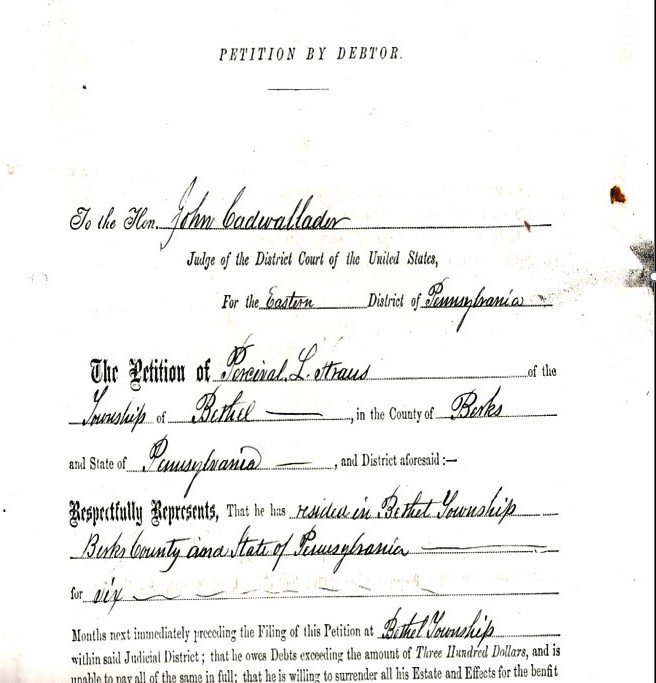
Petition by Debtor: Percival L. Strauss
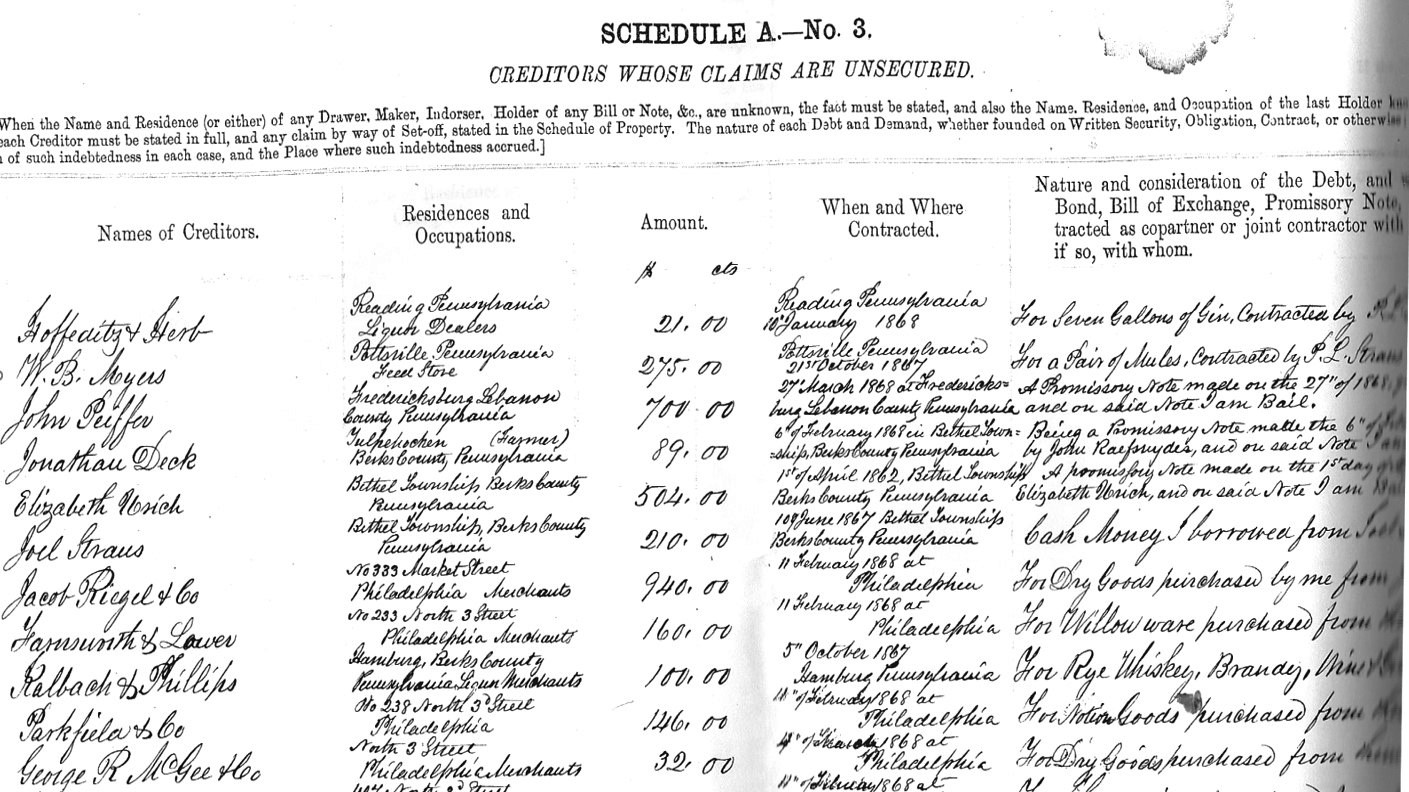
Schedule A – No. 3: Creditors Whose Claims are Unsecured (Percival L. Strauss)
2) Tintype of Percival L. Strauss-circa 1872 within a few years of filing Bankruptcy.

Percival L. Strauss. (Courtesy of Michael’s cousin Harry B. Strauss of Myerstown, PA)
Biographical information:
Percival Long Strauss (Son of Benjamin Strauss & Rebecca Long)
Born: December 16, 1830-Upper Bern Township, Berks Co. PA
Died: Mohnton, Berks Co. PA
Married: April 9, 1855-Bethel Township, Berks Co. PA to Malinda Smith (12 Children)
May 18, 1867 (Page 3, Column 6), in the Berks & Schuylkill Journal newspaper the entry reads: “P.L. Strauss of Bethel Twp. Berks County, PA Class #13 License paid $10.00 to conduct store (merchant).”
This is the business he had at the time of his bankruptcy filing on May 27, 1867 in Philadelphia, PA in the Eastern District of Pennsylvania.
Types of Information Found in Bankruptcy Records:
- Lists of creditors (name, address)
- Amount of money owed (the debt)
- Specific information about the items for which the debt was incurred
- Total dollar amounts
Follow the Federal Record Trail:
Information found could lead you to additional records. For example, if your ancestor filed for bankruptcy due to debts associated with his business, you could go back to the local level to look for records such as a business license, newspaper articles, etc.
Lisa suggests searching Google Books for digitized items such as county histories, almanacs, catalogs, merchant association books, etc. Here’s an example of a bankruptcy notice found in Google Books (which is free) for Michael’s ancestor Percival L. Strauss
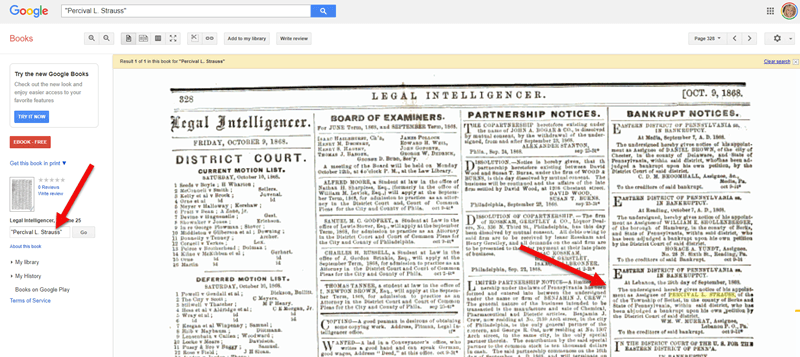
Searching for Percival L. Strauss bankruptcy notice in Google Books
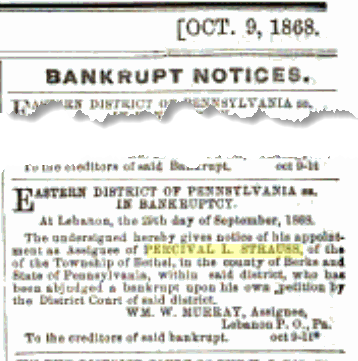
Bankruptcy notice (Oct. 9, 1868) found in Google Books
The National Archives has been consolidating all of the bankruptcy records. It is going to be the Kansas City, MO branch of the National Archives, which currently has the Patent files.
Examples of bankruptcy cases:
- Bankruptcy Act of 1841 – Edgar Allen Poe filed bankruptcy in 1841.
- Bankruptcy Act of 1898 Act – Dean Martin in New York
Amendments to the most recent bankruptcy act include:
1933: The “1898 Bankruptcy Act”
Amended to include railroad reorganization, corporate reorganization, and individual debtor arrangements.
1938: The “Chandler Act”
Amended the earlier 1898 Bankruptcy Act, creating a menu of options for both business and non-business debtors. Named for Walter Chandler.
1978: The 1898 Bankruptcy Act
Replaced by The Bankruptcy Reform Act. This Act is still used today.
Writs of Habeas Corpus:
Habeas corpus is a court order from a judge instructing a person who is detaining another to bring the detainee before the court for a specific purpose.
It was often used during the Civil War for soldiers under the age of 18 years and in reference to runaway slaves.
Writs can be found in most case files. They usually involves a petition, transcript, order, and the writ when ordered by the Judge. Contact the National Archives regarding RG19 for records pertaining to this set of documents and indexes.
Fugitive Slave Act:
The Fugitive Slave Act of 1850 was passed by the United States Congress on September 18, 1850 as part of the Compromise of 1850. It was one of the controversial acts passed down by law. Runaway slaves could be returned with the help of the Federal Government.
Records can include:
- Petitions
- Affidavits
- Testimonies
- Documentation of ownership
Records are typically found in the court of original petition and the court with jurisdiction over the area where the slave escaped. Search under the slave holder’s name.
The Confiscation Act of 1862:
Passed by an act of Congress on July 17, 1862, the full title is “An Act to Suppress Insurrection, to Punish Treason and Rebellion, to Seize and Confiscate the Property of Rebels, and for Other Purposes.”
This Act gave the power to take the land and businesses of persons who served the Confederacy. Records include case files include; petitions, orders of the court, proofs of public notice, and notices of seizure
Example: General Robert E. Lee. The act covered land under Union Control. Lee lived in Northern Virginia, and his home was confiscated. The file has a complete inventory of his house. The location is now the Arlington National Cemetery.
Federal Criminal Records
Criminal records could include cases covering:
- Treason
- Assault and Battery on the high seas
- Conspiracy to over through our government
- Smuggling
- Forgery
- Counterfeiting
- Carrying on a business without a license
- Not paying taxes
Naturalization Records:
Records were created:
- at the federal level
- at the local level – local court at the county level
1790: The first national act created a two-step process:
- Declare your intention to become a citizen
- File your petition for citizenship
Your ancestors may not have finished the process, and they may have filed both at local and federal levels.
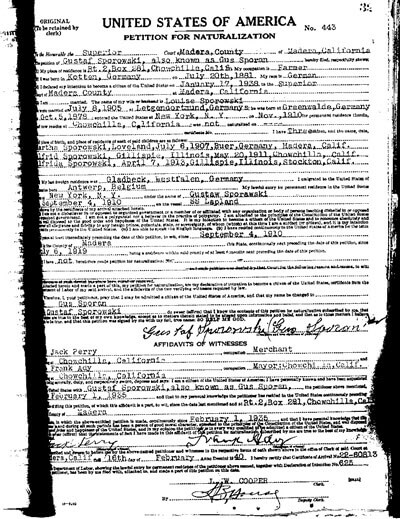
Petition for Naturaliztion
Resource: The Family History: Genealogy Made Easy Podcast
Episodes focusing on the Naturalization process include:
Episode 29: Immigration and Naturalization Records for Family History, Part 1
This episode begins a 3-part series on U.S. immigration and naturalization records. Learn about passenger arrival lists in the U.S., little-known certificates of arrival and naturalization records: how to find them and what’s in them.
Episode 30: Immigration and Naturalization Records for Family History, Part 2
In this episode we focus on passenger departure records created in European ports. He also talks more in-depth about U.S. naturalization records.
Episode 31: Immigration and Naturalization Records for Family History, Part 3
In-depth discussion of passenger list annotations and the immigrant’s experience at Ellis Island. Unlock the meaning of those mysterious scribbles on 20th-century passenger manifests!
Learn More with Michael Strauss:
Visit Michael’s Website: Genealogy Research Network
Register for Michael Strauss’ week-long Salt Lake Institute of Genealogy (SLIG) 2020 course called Court #2 A Guide to Treasures Found in Federal Records.
Hear More from Michael Strauss: Genealogy Gems Premium Membership
Gain access to the complete Premium podcast archive of over 150 episodes and more than 50 video webinars, including Lisa Louise Cooke’s newest video The Big Picture in Little Details.
More Reading:
Black, Henry Campbell. Black’s Law Dictionary. Sixth Edition. St. Paul: West Publishing, 1990.
Burton, William C. Burton’s Legal Thesaurus. New York: Macmillan Library Reference, 1998.
Chapin, Bradley. Criminal Justice in Colonial America, 1606–1660. Athens: University of Georgia Press, 1983
Eichholz, Alice ed., Red Book: American State, County, and Town Sources, 3rd Ed Provo: Ancestry, 2004.
Evans, Barbara Jean. The New A to Zax: A Comprehensive Genealogical Dictionary for Genealogists and Historians. Second Edition. Champaign: B.J. Evans, 1990
Neagles, James C. and Lila Lee Neagles. Locating Your Immigrant Ancestor: A Guide to Naturalization Records. Logan: Everton Publishers, 1986.
Rapaport, Diane. New England Court Records: A Research Guide for Genealogists and Historians. Burlington: Quill Pen Press, 2006
Rose, Christine. Courthouse Research for Family Historians. San Jose: CR Publications, 2004.
Schaefer, Christina. Guide to Naturalization Records of the United States. Baltimore: Genealogical Publishing Company, 1997.
Szucs, Loretto Dennis, and Sandra Luebking. The Archives: A Guide to the National Archives Field Branches. Salt Lake City: Ancestry Publishing, 1988.
Thank you to Michael Strauss for contributing to these notes and sharing his expertise!
This free podcast is sponsored by:
MyHeritage.com is the place to make connections with relatives overseas, particularly with those who may still live in your ancestral homeland. Visit www.MyHeritage.com
Learn German Handwriting
Katherine Schober of SK Translations, professional German script expert, translator, and author has created Reading the Old German Handwriting Online Course – so you can be reading those old German letters in just a matter of months. Complete with videos, flash cards, games, and more, this do-it-yourself course has students raving. Learn more here.
Read our latest articles at Genealogy Gems:
Dakota (AKA Kota Bear) makes Her Debut on this Episode

Please Help Us by Taking the 1 Minute Genealogy Gems Survey
Please help us create the best podcast for you by taking this very short survey.
Join Lisa Louise Cooke in person at Genealogy Roots
This event is now over.
Watch the video recap of Day 1 of Genealogy Roots in Salt Lake City:
Watch the video recap of Day 2 of Genealogy Roots in Salt Lake City:
Get the Genealogy Gems Podcast App Here
Follow Lisa and Genealogy Gems on Social Media:
- Instagram.com/genealogygemspodcast
- Facebook.com/genealogygems
- Pinterest.com/lisalouisecooke
- YouTube.com/GenealogyGems
Sign Up for the Free Genealogy Gems Newsletter
The Genealogy Gems email newsletter is the best way to stay informed about what’s available with your Premium eLearning Membership. Click below to sign up today.
Lisa Recommends Computer Backup with:
Learn more about Backblaze computer cloud backup and get your computer backed up today at www.backblaze.com/Lisa
Download the Show Notes PDF in the Genealogy Gems Podcast app.
Episode 194 Free Podcast Episode
The Genealogy Gems Podcast
with Lisa Louise Cooke
This blast from the past episode comes from the digitally remastered Genealogy Gems Podcast episodes 11 and 12 (originally recorded in 2007). They are now interwoven with fresh narration and updated show notes. Topics include: Google Images; Top 10 Tips for finding Graduation Gems in your family history; Display your family history with an easy to create Decoupage plate.

Did you know you can use Google to help identify images, to find more images like them online, and even to track down images that have been moved to a different place online? Find these great Google tech tips in this episode, along with 10 tech-savvy tricks for finding an ancestor’s school records. You will also hear how to create a family history photo decoupage plate: a perfect craft to give as a gift or create with children.
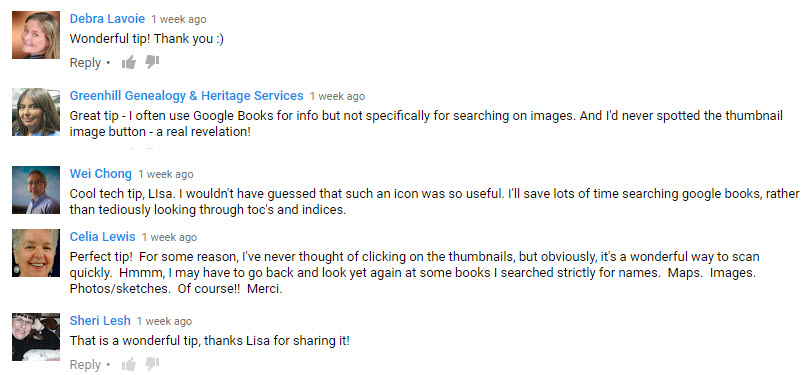
This “blast from the past” episode comes from the digitally remastered Genealogy Gems Podcast episodes 11 and 12 (originally recorded in 2007). They are now interwoven with fresh narration; below you’ll find all-new show notes.
Google Image searches: Updated tips
Click here to watch a short new tutorial video on using Google Images to find images for your genealogy research.
Conduct an initial search using the search terms you want. The Image category (along with other categories) will appear on the screen along with your search results. For images of people: enter name as search term in quotes: “Mark Twain.” If you have an unusual name or if you have extra time to scroll through results, enter the name without quotation marks. Other search terms to try: ancestral place names, tombstone, name of a building (school, church, etc.), the make and model of Grandpa’s car, etc.
Click on one of the image thumbnails to get to a highlight page (shown here) where you can visit the full webpage or view the image. If you click View images, you’ll get the web address.

To retrieve images that no longer appear at the expected URL: Click on View image to get the image URL. Copy the image’s URL (Ctrl+C in Windows) and paste it (Ctrl+V) into your web browser to go to that image’s page. When you click through, you’re back in Web view. The first few search results should be from the website with the image you want. Click on a link that says “cache.” A cached version is an older version of the website (hopefully a version dated before the image was moved or removed). Browse that version of the site to find the image.
NEW Tip: Use Google Chrome to identify an image and find additional images showing the same subject, such as a place, person or subject.
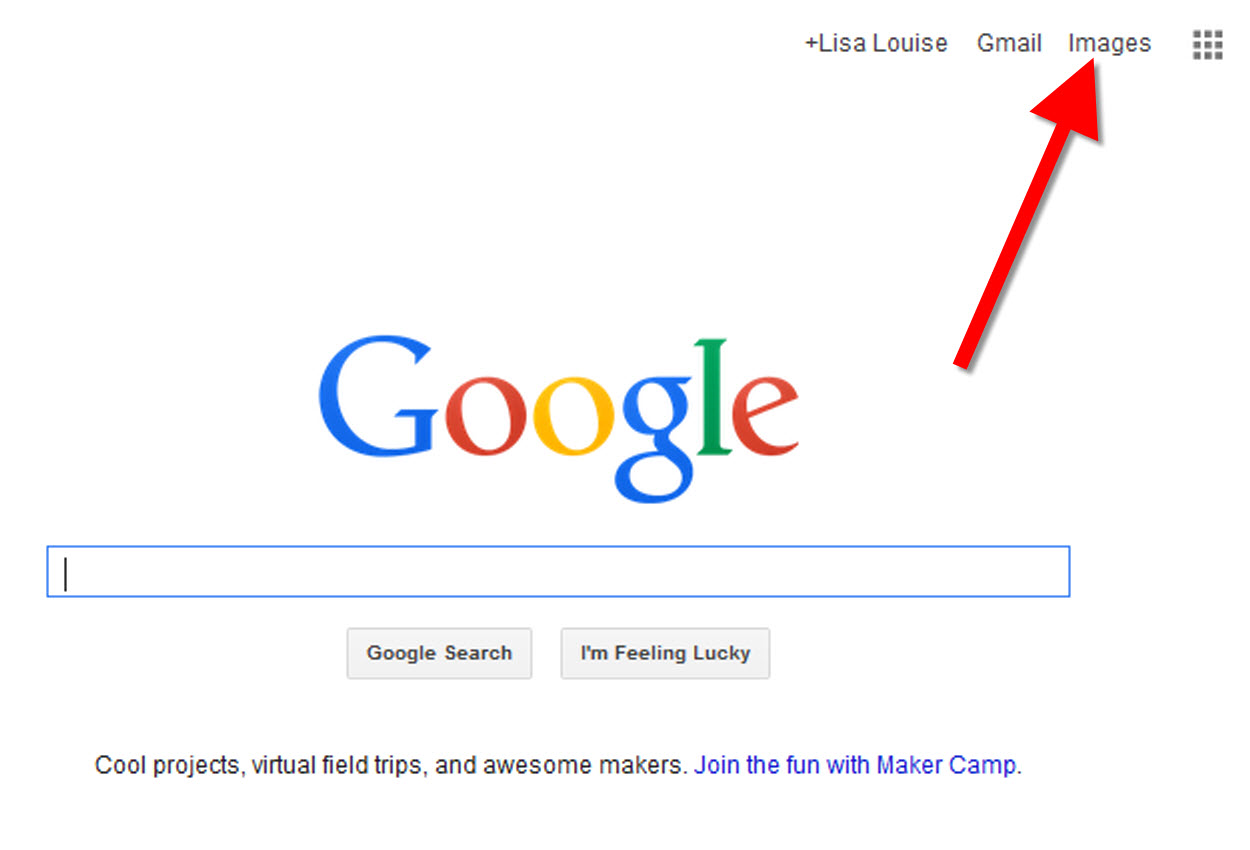
From the Google home page, click Images.
In the Google search box, you’ll see a little camera icon. Click on it.
If you have an image from a website, insert the URL for that image. If you have an image on your computer, click Upload an image. Choose the file you want.
Google will identify the image as best it can, whether a location, person, or object, and it will show you image search results that seem comparable.
Click here to watch a free video tutorial on this topic.
GEM: Decoupage a Family Photo Plate
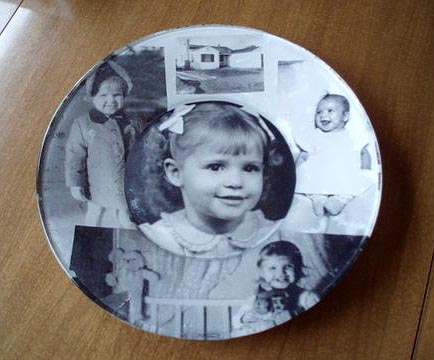
Supply List:
- Clear glass plate with a smooth finish (available at
kitchen outlet and craft stores) - Sponge craft brush
- Decoupage glue
- Fine paper-cutting scissors (Cuticle scissors work well)
- Small bottle of acrylic craft paint in a color you would like for the back
- A flat paintbrush
- Painter’s tape
- Brush-on clear acrylic varnish for a glossy finish on the back of the plate
- A selection of photos (including other images that complement the photos)
Assembling your plate:
- Lay out your design to fit the plate
- Add words if desired. You can draw directly on the copy or print it out and cut it to fit.
- Put an even coat of glue on the front of each photo. Don’t worry about brush strokes, but be careful not to go over it too many times which could cause the ink to run.
- Apply the photos to the back of the plate, working in reverse order (the first images placed on the plate will be in the foreground of the design). Glue the edges firmly. Turn the plate over to check the placement of images. Smooth using craft brush.
- Brush glue over the back of each photo.
- Turn the plate around so you can see the image from the front and work out the air bubbles.
- Continue to place the images until the entire plate is covered. Let it dry 24 hours.
- Use painters’ tape to tape off the edges before you apply the acrylic paint to the back of the plate. Paint the back and let dry. Apply a second coat. Let dry.
- Apply an acrylic varnish for a glossy finish on the back. Let dry.
Lisa Louise Cooke uses and recommends RootsMagic family history software. From within RootsMagic, you can search historical records on FamilySearch.org, Findmypast.com and MyHeritage.com. And it is in the works for RootsMagic to be fully integrated with Ancestry.com, too: you’ll be able to sync your RootsMagic trees with your Ancestry.com trees and search records on the site.
Keep your family history research, photos, tree software files, videos and all other computer files safely backed up with Backblaze.com/Lisa, the official cloud-based computer backup system for Lisa Louise Cooke’s Genealogy Gems.
GENEALOGY GEMS BOOK CLUB
Our current book is Everyone Brave is Forgiven by Chris Cleave. Follow the story of Mary North, a wealthy young Londoner who signs up for the war effort when the Great War reaches England. Originally assigned as a schoolteacher, she turns to other tasks after her students evacuate to the countryside, but not before beginning a relationship that leads to a love triangle and long-distance war-time romance. As her love interest dodges air raids on Malta, she dodges danger in London driving ambulances during air raids in the Blitz.
This story is intense, eye-opening and full of insights into the human experience of living and loving in a war zone and afterward. Everyone Brave is Forgiven is inspired by love letters exchanged between the author’s grandparents during World War II.
Video: Chris Cleave on the U.S troops coming to Europe in World War II
Click here for more Genealogy Gems Book Club titles
GEM: Top 10 Tips for finding Graduation Gems in your family history
- Establish a timeline. Check your genealogy database to figure out when your ancestor would have attended high school or college.
- Consult family papers and books. Go through old family papers & books looking for senior calling cards, high school autograph books, journals and diaries, senior portraits, fraternity or sorority memorabilia and yearbooks.
- Search newspapers. Look for school announcements, honor rolls, sports coverage, end-of-year activities and related articles. Updated tips and online resources:
Ancestry.com has moved the bulk of its historical newspaper collection to its sister subscription website, Newpapers.com.
Search your browser for the public library website in the town where your ancestor attended school. Check the online card catalogue, look for a local history or genealogy webpage, or contact them to see what newspapers they have, and whether any can be loaned (on microfilm) through interlibrary loan.
Search the Library of Congress’ newspaper website, Chronicling America, for digitized newspaper content relating your ancestor’s school years. Also, search its U.S. Newspaper Directory since 1690 for the names and library holdings of local newspapers.
FamilySearch.org online catalog
Contact local historical and genealogical societies for newspaper holdings.
- Consult the websites of U.S. state archives and libraries: click here to find a directory of state libraries
- State historical and genealogical societies. In addition to newspapers, state historical and genealogical societies might have old yearbooks or school photograph collections. For example, the Ohio Genealogical Society library has a large (and growing) collection of Ohio school yearbooks. Local historical and genealogical societies may also have school memorabilia collections.
- RootsWeb, now at http://www.rootsweb.ancestry.com. Check the message board for the county and state you’re looking for. Post a message asking if anyone has access to yearbooks or other school info.
TIP: Use Google site search operator to find mentions of yearbooks on the county page you’re looking at. Add site: to the front of the Rootsweb page for the locale, then the word yearbook after it. For example:
- Search for online yearbooks at websites such as:
- Old-Yearbooks.com
- Classmates.com
- Ancestry.com now has a large yearbook collection
Yearbookgenealogy.com and the National Yearbook Project, mentioned in the show, no longer exist as such
- US GenWeb at www.usgenweb.org. Search on the county website where the school was located. Is there anyone willing to do a lookup? Is there a place to post which yearbooks you’re looking for?
- Call the school, if it’s still open. If they don’t have old yearbooks, they may be able to put you in touch with a local librarian or historian who does.
TIP: Go to www.whowhere.com and type the school name in “Business Name.” Call around 4:00 pm local time, when the kids are gone but the school office is still open.
- ebay: Do a search on the school or town you’re looking for to see if anyone out there is selling a yearbook that you need. Also search for old photographs or postcards of the school. Here’s my extra trick: From the results page, check the box to include completed listings and email potential sellers to inquire about the books you are looking for.
TIP: Don’t be afraid to ask ? ebay sellers want to sell! And if all else fails, set up an ebay Favorite Search to keep a look out for you. Go to and check out Episode #3 for instructions on how to do this.
MyHeritage.com is the place to make connections with relatives overseas, particularly with those who may still live in your ancestral homeland. Click here to see what MyHeritage can do for you: it’s free to get started.
FREE NEWSLETTER:
Subscribe to the Genealogy Gems newsletter to receive a free weekly e-mail newsletter, with tips, inspiration and money-saving deals.
Disclosure: This article contains affiliate links and Genealogy Gems will be compensated if you make a purchase after clicking on these links (at no additional cost to you). Thank you for supporting Genealogy Gems!

